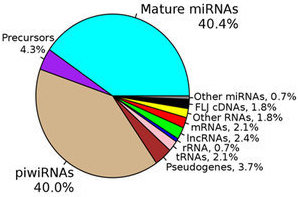Members of the Extracellular RNA Communication Consortium have recently elucidated a mechanism through which hypoxia leads to increased tumor aggressiveness and metastasis. Anil Sood and his group at University of Texas MD Anderson Cancer Center have identified a miRNA that downregulates the very pathway responsible for miRNA biogenesis, a finding that should generate excitement due to the identification of a potential new way of treating cancers: through miRNA or RNA interference-based gene targeting.
The development of tumors is a complex process that involves the cooperation of cancer cells with non-cancer cells, together making up the tumor microenvironment that is vital for tumor survival. As tumors grow and become dense, they begin signaling for the formation of new blood vessels to bring oxygen and nutrients to their core, a process called angiogenesis. Inhibiting angiogenesis is thus a highly attractive therapeutic avenue and is typically accomplished through the targeting of vascular endothelial growth factor (VEGF) and the subsequent induction of hypoxia, or a condition of low oxygen, in the tumor. Hypoxia, however, comes with its own set of problems.
The recent study suggests that hypoxia itself can lead to an increase in the aggressiveness and metastatic potential of a tumor (Rupaimoole et al, 2016). Previous studies have found that hypoxic conditions lead to the downregulation of Drosha and Dicer, two components of the miRNA biogenesis pathway, and that this decrease in expression is associated with poor clinical outcomes through a decrease in the pool of miRNA present in the tumor. In investigating the root cause of Dicer downregulation, Sood and his team identified a miRNA, miR-630, that is upregulated during hypoxia and that targets the 3’ UTR of Dicer. The study validated this targeting by monitoring Dicer mRNA and protein levels both in cells and in vivo in mouse models. Mice that had miR-630 delivered to them via nanoliposomes developed larger tumors and metastases in more places than control mice.
Of particular importance, the researchers treated mice with a combination of anti-miR-630 or anti-VEGF therapy (bevacizumab). Mice that were treated with both bevacizumab and anti-miR-630 developed smaller tumors and fewer metastatic nodules compared with mice treated with bevacizumab alone; Dicer expression was rescued upon treatment with anti-miR-630.
Apart from furthering our understanding of Dicer regulation during cancer, this research demonstrates the potential of treating cancers with anti-miRNA therapies, which would be particularly useful in situations where antibodies or chemical agents are not able to reach a target.


